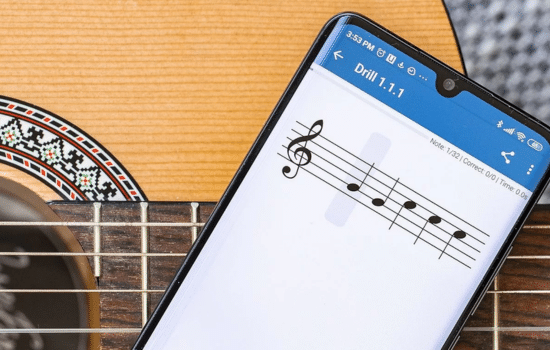Learning to play a musical instrument is a desire shared by millions of people around the world. Among all instruments, the violin (guitar) stands out as one of the most popular.
Its versatility, its ability to adapt to different musical genres, and the fact that it can be started with a relatively low investment make it a favorite choice. However, learning to play the violin on your own can be a challenge.
That's where technology, particularly free apps, becomes the best ally for those who want to master this instrument without having to spend money on private lessons or academies.
Today, access to mobile apps has democratized music learning, allowing anyone to begin their musical journey from home.
As a digital marketing professional, I've observed how music education has found a new avenue for growth through mobile platforms. And it's precisely this growth that leads us to take a deeper look at why violin apps are gaining so much attention.
Why learn violão through an application?
Before we talk about specific names, it's important to understand why people are turning to apps instead of traditional methods. The answer can be summed up as comfort, accessibility and customization.
With an application:
- You can learn anywhere, anytime.
- You can repeat the lessons as many times as you need.
- Progress is monitored and adapted to your level.
- You don't need any previous knowledge.
- You can practice at your own pace, without external pressure.
Plus, thanks to audio and video recognition technologies, these apps can now listen to your playing, correct you, and give you feedback in real time.
The impact of digital learning on the music market
From a marketing perspective, the rise of music learning apps represents a shift in consumer behavior. People of all ages are rediscovering music as a form of therapy, personal development, and connection with others.
Searches related to “how to learn to play the violin” have grown exponentially on platforms like Google and YouTube.
At the same time, app stores are full of free and paid tools that promise quick results. But, as in any digital market, quality makes the difference, and that is where we must be strategic when choosing.
Essential features that a good application should have
Working with user experience analytics and conversion optimization, I've learned that there are certain elements that determine whether an app is truly worthwhile:
- User-friendly interface: It should be intuitive, especially for beginners.
- Clear progression: A defined path from basic to advanced.
- Quality audiovisual content: Well-produced video lessons.
- Real-time feedback: Use of technology to correct errors.
- Achievement and motivation system: To maintain user engagement.
- Constant updates: Fresh content that keeps things fresh.
In my experience, apps that retain users for more than 30 days tend to have an effective combination of these elements. But the most successful ones also understand that teaching isn't enough: They must entertain while they teach.
What are users looking for when they want to learn the violin?
Based on data from campaigns and social media behavior, users who download these types of apps tend to have a few things in common:
- They are self-taught or want to be.
- They have little free time and are looking for short lessons.
- They want to learn familiar songs as quickly as possible.
- They value practice more than theory.
- Many of them have already given up on other methods before.
This gives us an important clue as to how lessons should be structured: direct, practical, with quick rewards and visible results from day one.
The most common mistakes when starting to play the violin
Many beginners face unnecessary frustration because they don't receive proper guidance. Some of the most common mistakes include:
- Not tuning the instrument correctly.
- Adopting uncomfortable postures that make learning difficult.
- Starting with songs that are too difficult.
- Not developing strength or coordination between right and left hand.
- Not practicing regularly.
Well-designed apps correct these errors from the first module, providing step-by-step guidance with explanatory videos, progressive exercises, and simple practice.
The moment of revelation: the app that stands out
After working with multiple applications and analyzing metrics such as average usage time, retention rate, store ratings, and user feedback, I can say that one of the most complete and recommendable applications for learning to play the violin is Simply Guitar.
This app has revolutionized guitar learning on mobile devices thanks to its smart listening technology and hands-on approach. Unlike others, Simply Guitar actually listens to what you're playing and adapts lessons accordingly.
Why is Simply Guitar a good choice?
1. Real-time recognition technology
The app detects whether you're playing the correct chords and automatically corrects them. This prevents you from learning incorrectly from the start.
2. Visual and practical lessons
The videos are very well produced, with clear explanations, close-up shots of hands, and musical examples you can follow.
3. Learning based on popular songs
From the very first module, you're already playing excerpts from familiar songs. This motivates and maintains the student's interest.
4. Structured progression
It has a level system that allows each person to advance at their own pace, without unnecessary jumps or frustrations.
5. Community and support
Users can share progress, achievements, and receive help through forums and integrated technical support.
The importance of combining consistency and fun
An app alone doesn't work miracles. The secret is in the user discipline, but also in how the app makes the learning process pleasant, light and steady.
Simply Guitar keeps users engaged with smart notifications, weekly challenges, and a clean interface.
Content is unlocked as you progress, stimulating curiosity and a sense of accomplishment. And that, from a digital marketing perspective, is pure gold.
How to get the most out of a guitar learning app
If you decide to start learning the violin with an app like Simply Guitar, keep these practical tips in mind:
- Practice at least 15 minutes a day.
- Use headphones if possible, to hear the chords better.
- Don't skip the introductory modules, even if you already have prior knowledge.
- Always tune your instrument before practicing.
- Don't be afraid to repeat a lesson if it didn't go well.
See also:
- Free apps to learn karate at home
- Listening to free radio is back in fashion
- New users learn mechanics with free apps
- Cell phones now ring louder for free
- Mobile phones turn your screen into a tape measure
Conclusion: Your musical future starts today
Nowadays, there are no excuses for not learning to play the violin. With apps like Simply GuitarYou have in your hands a powerful, free and effective tool that can change your relationship with music forever.
What was once exclusive to those with the money or time to pay for classes is now available on any smartphone. Technology is leveling the playing field and allowing millions to discover talents they didn't even know they had.
And if, in addition to learning, you want to share your progress, record your own songs, or simply play for your friends and family, it all starts with that first step. So install, try, and Let your passion for music speak for you.


